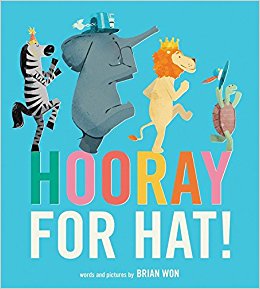Introduction: Our next book is called Hooray for Hat by Brian Won. In this book each of the animals is grumpy until they get a wonderful hat. Then when Elephant gives each animal a hat they all say "Hooray for hat." You can help me tell the story by saying "Hooray for hat." Let's practice saying "Hooray for hat." Good!
[Read the book, pausing for them to say "Hooray for hat."]
Now I have a flannel board of this same book. You already said "Hooray for hat," and now you can help tell the whole story!
[Put up pieces on the flannel board, pausing for the children to tell you what comes next, and to say as much of the story as they can.
Early Literacy Aside--Example: Adults, we help children retell stories, they can remember it more easily, and they also are learning how stories work--what happens first, next, and last--and phrases that are repeated. Learning how stories work will make it easier for them to both understand stories when they read them and even to write stories when they are asked to do so in school.
Photos of pieces for flannel board of Hooray for Hat
Joseph Had an Overcoat by Simms Taback
Read book: Joseph Had an Overcoat by Simms TabackHave children say the repeated phrase, "But it got old and worn."
Retell with flannel board: Now let's do the story on the flannel board. What happened first?
Early Literacy Aside--Empower: [As you give out the handout] I have a handout for you today for Joseph Had an Overcoat. It is the same pattern that I used for the flannel board. You can cut out the pieces and have your children retell the story. As you have your children retell other stories too, using props can help them remember what comes next. For your younger children who may not be able to retell stories, they can repeat a word or perhaps a phrase. These are all activities that will later help your child understand how stories work and also help them understand what they read. Pattern for flannel board and handout: josephovercoathandout
Something from Nothing by Phoebe Gilman
Early Literacy Aside--Empower: Earlier in our storytime we read the book Something from Nothing and then you helped tell the story with the flannelboard. Today I have a handout for you, so that you can color and cut out the pieces from the rectangular blanket and then retell the story at home. Adults, when you give your children little aids or props, it helps them remember the story and retell it. When children retell stories they are better understanding how stories work as well as the story itself. This will help them later understand what they read. Have fun together!Handout: handsomnothpattskill
Library Staff: You can enlarge the handout to make your own flannelboard.
Submitted by Saroj Ghoting, Early Childhood Literacy Consultant www.earlylit.net
Baby's Bath with flannel board
This rhyme, I'll do with the flannel board. First I'll say the rhyme, and put up the figures. Then we'll all say the rhyme together.Baby's ready for a bath. Here's the baby's tub. Here's the baby's washcloth. Rub a dub a dub. Here's the baby's cake of soap, And here's the towel to dry, And here's the baby's cradle, Rock-a-baby-bye.
Early Literacy Aside--Example: As we say rhymes with our young children they hear both the rhythm of language and the rhymes. Being exposed to rhymes helps them hear the smaller sounds in words, a first step in later learning to read.
by Amy Alapati and Virginia Krute, Montgomery County (MD) Public Library, based on version in Ring a Ring o’ Roses, 9th ed. Flint Public Library, Permission granted Flint Public Library, Flint, MI
Fill a Tub with Water flannel board
Introduction to flannel board: Let's see what happens when you fill the tub with water. What might we see in the bathtub? Each line starts with "Fill the tub with water, what do you see?" Let's say that together. . . . Good!
Fill the tub with water, what do you see? I see bubbles floating in the bathtub sea. Fill the tub with water, what do you see? I see a washcloth floating in the bathtub sea. Fill the tub with water, what do you see? I see a cake of soap floating in the bathtub sea. Fill the tub with water, what do you see? I see a shampoo bottle floating in the bathtub sea. Fill the tub with water, what do you see? I see a little boat floating in the bathtub sea. Fill the tub with water, what do you see? I see a pouring cup floating in the bathtub sea. Fill the tub with water, what do you see? I see a toy shark floating in the bathtub sea. Fill the tub with water, what do you see? I see some swim goggles floating in the bathtub sea. Fill the tub with water, what do you see? I see a watering can floating in the bathtub sea. Fill the tub with water, what do you see? I see a rubber ducky floating in the bathtub sea. Fill the tub with water, what do you see? I see a nice clean baby splashing in the bathtub sea.
Early Literacy Aside--Empower: Even when you are giving your children a bath, naming the objects, describing them, talking about floating and sinking, heavy and light, as they play with toys in the bath; these are good ways to expand their knowledge and vocabulary which will later help them understand what they read.
by Amy Alapati and Virginia Krute, Montgomery County (MD) Public Library Flannel board pattern: filltubwaterFB
Freight Train with flannel board

Preparation: Use the attached pattern to cut out large flannel board pieces. You can make the pictures smaller to cut out pieces that you will hand out to the storytime participants. Activity: We have just read the book Freight Train by Donald Crews. Now let's play a matching game on the flannel board. Here is the whole train. [Put up the cars of the train and name them. Describe their color, shape, etc. Pass out one car to each of the storytime participants. Remove your whole train. Put up one car and describe it.] I have put up the cattle car. It is green and looks like a rectangle. It has two lines in the middle that cross each other. They look like an X. Several of you have a green cattle car. If you do, come up and make your match on the flannel board. Good job! [Continue with other cars.]
Early Literacy Aside--Example: When we play matching games with children, we help them notice characteristics of objects, what is similar and different. This type of thinking will later help them notice differences and similarities in letters as they learn to identify letters and learn to read.
Flannel board pattern: freighttrainFB
small cars can be used for individual handout
Shapes Flannel Board and Matching Game
Preparation for Presenter: Using cutouts of different shapes (see attachment below) make shapes you can use on the flannel board. If you want to play the matching game in addition to talking about shapes, make more than one of each shape.
Introduction: Today we talked about shapes and alike and different. So let’s see what shapes you see up here. Depending on the size, age-level and attention span of the group, you can put the shapes up yourself or hand them out to the toddlers and have them put the shapes up on the flannel board. Say the name of the shape as well as some additional description. For example, "Here is a circle, a small blue circle.” Have the children repeat the name of the shape and/or the description.]
Early Literacy Aside--Example: Helping your child notice and talk about shapes later helps them identify letters. When you think of an upper case A, there is a triangle shape in it. For Matching Game: You keep one copy of each shape and pass out the additional copies of the shapes. Put up one shape, say what it is and describe it. Then have those children who have the same shape come up to the flannel board to add theirs to yours. Don't forget to clap for each person. Adults are welcome to help their children.
Early Literacy Aside--Example: Playing matching games helps your child notice what is alike and different. This is one part of developing letter knowledge.
Matching Game Variation: You can make the matching more challenging by making patterns on your shapes. For example, you may color a couple of circles on a square, or make a design on two copies of the same shape. You can make the matching more or less challenging by how intricate or obvious the differences are. Use the handout of shapes for parents and children to cut out and play with at home. Early Literacy Aside for Shape Handout--Empower: This handout has several shapes you can cut out at home. You can use them as patterns and cut them out of different color paper. You can draw on them to make different patterns to match as well. You might ask your toddler to put all the circles together, all the ones with straight lines, all the ones with the same color. Sorting is one way of noticing what is alike and different. When children try to recognize letters they will need this skill. Think of a lower case h and a lower case n. They look similar but they are also different.
Adult/Child Animal Flannel Board
Introduction: Our next activity is with animals and what they are called. Baby animals are often called something different from the adult animal. This activity helps your children learn these words.[Put up adult and baby animal figures as you say their names, having children repeat them with you. If you like you can pass out the baby animals to each child. You put up the adult animal and the child puts up the matching baby animal as you say the name of it. Have children repeat the words for both adult and baby animals. Encourage adult to help if needed.]
Early Literacy Aside--Example: Saying the words for both the adult and baby animals helps to develop your children’s vocabulary.
Early Literacy Aside--Empower: Today you saw how we can expand children's vocabulary by giving specific names to things. We did it with animals. You can do the same with the vehicles you see all around you. If your child is calling everything that goes a car, you can say, yes, that’s a car, that’s an SUV, that’s a van, that’s a pick-up truck, and so forth. Even if they can’t say all these words, hearing you say them is how they begin to learn these words. You can also add description, like that shiny yellow car with silver hubcaps. These little things you do throughout the day in enjoyable ways all build your child's vocabulary which later helps them understand what they read.
Shape Bee

Early Literacy Aside--Example: Before children learn letters, they learn shapes. Let them play with shapes to develop later letter knowledge. Flannel Board: Do Shape Bee on flannel board. See attachment for pattern Shape Bee pattern Craft Activity: You can use the pattern as a basis to have the children make their own Shape Bee. Early Literacy Aside--Empower: Wherever you go today, look for the letter B, on signs, in books, on products. Then you can do the same with other letters throughout the week.
Submitted by Erin Nguyen, Public Library of Charlotte and Mechlenburg County (NC)
Way Down Deep in the Deep Blue Sea by Jan Peck
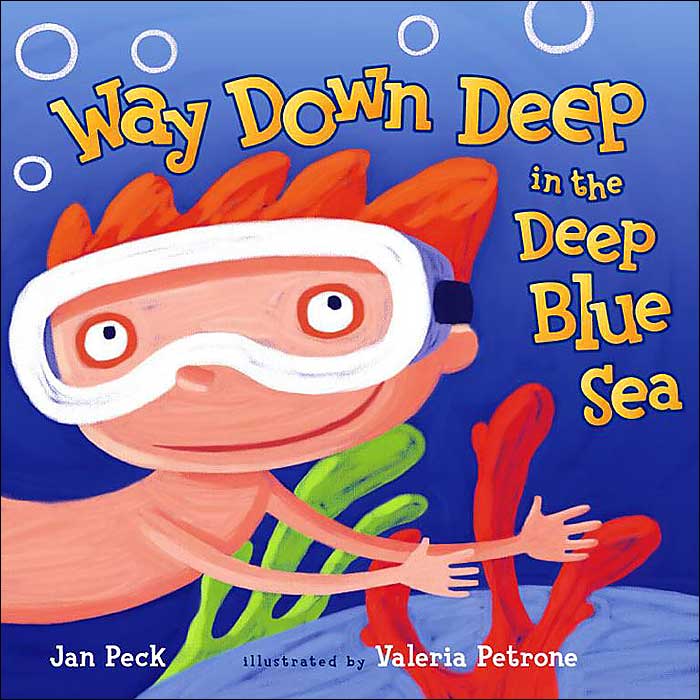 Introduction: I am going to read our next book, Way Down Deep in the Deep Blue Sea by Jan Peck. Then you can tell it with me on the flannel board.Read Way Down Deep in the Deep Blue Sea. Repeat some of the rhymes to help them remember.
Flannel Board: As you put up pieces on the flannel board have the children retell the story.
Early Literacy Aside--Example: Using the flannel board pieces as a clue will help your child remember the story to retell it. Encouraging your children to retell stories helps them to both remember and to understand them. It is a first step in helping them to later understand what they will read.
Introduction: I am going to read our next book, Way Down Deep in the Deep Blue Sea by Jan Peck. Then you can tell it with me on the flannel board.Read Way Down Deep in the Deep Blue Sea. Repeat some of the rhymes to help them remember.
Flannel Board: As you put up pieces on the flannel board have the children retell the story.
Early Literacy Aside--Example: Using the flannel board pieces as a clue will help your child remember the story to retell it. Encouraging your children to retell stories helps them to both remember and to understand them. It is a first step in helping them to later understand what they will read.
Submitted by Stem Saunders, Steele Creek Library, Public Library of Charlotte and Mechlenburg County (NC)
Old Macdonald Had a Farm Flannel Board
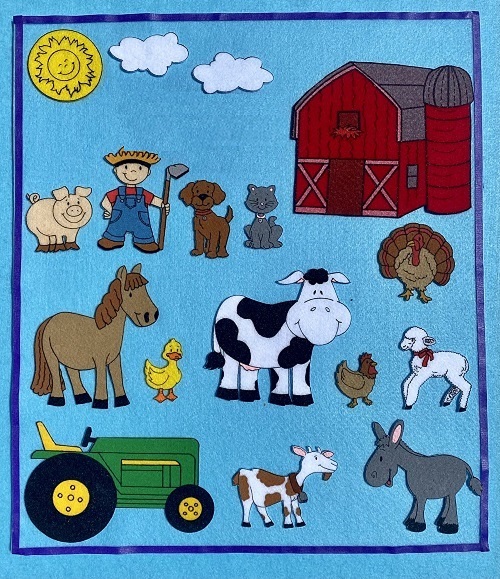 Pass out flannel board pieces of fam animals. Play or sing "Old Macdonald Had a Farm" . When a child hears the animal he/she is holding, that child comes up to place the animal piece on the flannel board.Early Literacy Aside--Example: Having your children hear and make the sounds of the animals is one enjoyable way to help them develop phonological awareness, to eventually be able to hear the smaller sounds in words.
Take-Home Activity: Hand out shapes of animals for families to take home.
Early Literacy Aside--Empower: Parents, you can use these animal shapes to make animal sounds with your children and home and sing the song with them to practice the skill of phonological awareness.
Pass out flannel board pieces of fam animals. Play or sing "Old Macdonald Had a Farm" . When a child hears the animal he/she is holding, that child comes up to place the animal piece on the flannel board.Early Literacy Aside--Example: Having your children hear and make the sounds of the animals is one enjoyable way to help them develop phonological awareness, to eventually be able to hear the smaller sounds in words.
Take-Home Activity: Hand out shapes of animals for families to take home.
Early Literacy Aside--Empower: Parents, you can use these animal shapes to make animal sounds with your children and home and sing the song with them to practice the skill of phonological awareness.
Submitted by Helen Patzer, Dayton (OH) Metro Library, Northtown-Shiloh Branch.
Candlewick Press Storytime Plan
Storytime Plan includes these books with suggested activities and relation to the early literacy skills.Arabella Miller's Tiny Caterpiller by Clare Jarrett On the Farm by David Elliott A Visitor for Bear by Bonny Becker Tweedle Dee Dee by Charlotte Voake [Some activities are more for school-age children.] readtousstoryhourkit.pdf
Orange Pear Apple Bear by Emily Gravett
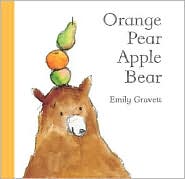
Re-tell the story using flannel pieces with the children telling the story as you put the pieces on the board. As the whole story has four words the children learn it quickly. This book can also be used to demonstrate narrative skills.
Submitted by Leslee Farish Kuykendal, Chicago Public Library
Rain by Robert Kalan
 Read the book Rain by Robert KalanEarly Literacy Aside--Example: It is really important for children to be able to tell and re-tell stories or ideas in chronological order. We are going to use this flannel board (Rain flannel board) to let the children re-tell the story we just read. Plus, they will see how each item affects the next one. This activity will help them develop their narrative skills which later helps them understand what they read.
Flannel Board: Place pieces on the flannel board as the children retell the story.
You can use some of the pieces from the flannel board pattern as a handout so that the children can retell the story at home.
Submitted by Jaime Duval and Whitney Whitaker, Radford (VA) Public Library
Read the book Rain by Robert KalanEarly Literacy Aside--Example: It is really important for children to be able to tell and re-tell stories or ideas in chronological order. We are going to use this flannel board (Rain flannel board) to let the children re-tell the story we just read. Plus, they will see how each item affects the next one. This activity will help them develop their narrative skills which later helps them understand what they read.
Flannel Board: Place pieces on the flannel board as the children retell the story.
You can use some of the pieces from the flannel board pattern as a handout so that the children can retell the story at home.
Submitted by Jaime Duval and Whitney Whitaker, Radford (VA) Public Library
Very Busy Spider by Eric Carle
 Talk about spiders and how they spin their webs. Each web is different. They use their webs to catch their food.Read the book The Very Busy Spider by Eric Carle.
Put up pieces on a flannel board, having the participants retell the story as you put up the pieces.
Early Literacy Aside--Example: This book has lots of repetition so it is a good one for retelling. I have a handout with the same figures that I used on the flannel board. I will also pass out some yarn to make the web. You can cut out the figures and use the yarn to retell the story. Helping your children to retell stories will help them understand what they read later in school.
Talk about spiders and how they spin their webs. Each web is different. They use their webs to catch their food.Read the book The Very Busy Spider by Eric Carle.
Put up pieces on a flannel board, having the participants retell the story as you put up the pieces.
Early Literacy Aside--Example: This book has lots of repetition so it is a good one for retelling. I have a handout with the same figures that I used on the flannel board. I will also pass out some yarn to make the web. You can cut out the figures and use the yarn to retell the story. Helping your children to retell stories will help them understand what they read later in school.
Figures for flannel board and handout verybusyspiderpatterns.doc [For the flannel board, an alternative to using the cutout figure of the spider is to make a spider by stapling two small paper plates together. Cut strips of black construction paper and attach to paper plates for legs. Slip yarn between the stapled paper plates with a bit sticking out to start the web. Pull out the yarn as you make the web on the flannel board. If you need to you can use velcro or pins or tacks to hold the yarn to the flannel board. Tell the children that spiders don't need that--the web itself is sticky.]
Bear Went Over the Mountain--Rhyming Song
Song: The Bear Went Over the MountainThe bear went over the mountain, the bear went over the mountain The bear went over the mountain, to see what he could see. And what do you think he saw? And what do you think he saw? He saw a goat in a boat, he saw a goat in a boat. He saw a goat in a boat, That is what he saw.
Go through the song.
Early Litearcy Aside--Example: Rhyming is an important part of phonological awareness. It helps children break down words into smaller sounds and identify similar sounds in different words.This skill will help them when they sound out words to learn to read. Re-sing the song putting up different felt figures (skunk in a trunk) and allow the children to tell you what they see.
Early Literacy Aside--Empower: You can sing this song with any rhyming words. Work together with your child to create another verse. Don't be afraid to use nonsense words! Submitted by Erin Rogers, Henrico County (VA) Public Library--Gayton Branch
Blue Sea by Robert Kalan
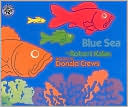
Read the book Blue Sea by Robert Kalan. Use the flannel board to retell the story. You put up the pieces and have the participants retell the story as you put up the pieces. You may say a few words to prompt them.
Early Literacy Aside--Example: Giving children an aid, like the flannel board pieces, helps them remember the story and the order. This helps them develop their narrative skills which both helps them later understand what they will read and helps them understand how stories work.
At the end of storytime, offer a handout (see below)
Early Literacy Aside--Empower: Today I have a handout for Blue Sea for you. You and your children can color and cut out the pieces and then retell the story together. Remember that telling stories will help children later in school when they have to write their own stories.
Patterns for flannel board pieces
Handout for retelling at home
Submitted by Saroj Ghoting

